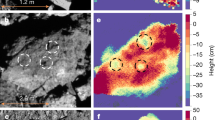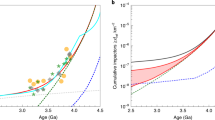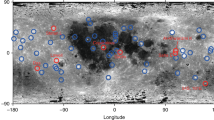Abstract
Asteroids with diameters smaller than ∼50–100 m that collide with the Earth usually do not hit the ground as a single body; rather, they detonate in the atmosphere1. These small objects can still cause considerable damage, such as occurred near Tunguska2, Siberia, in 1908. The flux of small bodies is poorly constrained, however, in part because ground-based observational searches pursue strategies that lead them preferentially to find larger objects3. A Tunguska-class event—the energy of which we take to be equivalent to 10 megatons of TNT—was previously estimated to occur every 200–300 years, with the largest annual airburst calculated to be ∼20 kilotons (kton) TNT equivalent (ref. 4). Here we report satellite records of bolide detonations in the atmosphere over the past 8.5 years. We find that the flux of objects in the 1–10-m size range has the same power-law distribution as bodies with diameters >50 m. From this we estimate that the Earth is hit on average annually by an object with ∼5 kton equivalent energy, and that Tunguska-like events occur about once every 1,000 years.
This is a preview of subscription content, access via your institution
Access options
Subscribe to this journal
Receive 51 print issues and online access
$199.00 per year
only $3.90 per issue
Buy this article
- Purchase on Springer Link
- Instant access to full article PDF
Prices may be subject to local taxes which are calculated during checkout




Similar content being viewed by others
References
Hills, J. G. & Goda, P. Damage from the impacts of small asteroids. Planet. Space Sci. 46, 219–229 (1998)
Sekanina, Z. Evidence for the asteroidal origin of the Tunguska object. Planet. Space Sci. 46, 191–204 (1998)
Morrison, D., Chapman, C. R. & Slovic, P. Hazards due to Comets and Asteroids (ed. Gehrels, T.) 59–91 (Univ. Arizona Press, Tucson, 1994)
Shoemaker, E. M. Asteroid and comet bombardment of the Earth. Annu. Rev. Earth Planet. Sci. 11, 461–494 (1983)
Tagliaferri, E., Spalding, R., Jacobs, C., Worden, S. P. & Erlich, A. Hazards due to Comets and Asteroids (ed. Gehrels, T.) 199–221 (Univ. Arizona Press, Tucson, 1994)
McCord, T. B. et al. Detection of a meteoroid entry into the Earth's atmosphere on February 1, 1994. J. Geophys. Res. 100, 3245–3249 (1995)
Ceplecha, Z. et al. Meteor phenomena and bodies. Space Sci. Res. 84, 327–471 (1998)
Nemtchinov, I. et al. Assessment of kinetic energy of meteoroids detected by satellite-based light sensors. Icarus 130, 259–274 (1997)
Ceplecha, Z., Spalding, R. E., Jacobs, C. & Tagliaferri, E. Proc. SPIE 2813, 46–56 (1996)
ReVelle, D. O. A predictive macroscopic integral radiation efficiency model. J. Geophys. Res. 85, 1803–1808 (1980)
ReVelle, D. O. Meteoroids 2001—Conference Proceedings SP-495 (ed. Warmbein, B.) 513–519 (European Space Agency, Noordijwk, The Netherlands, 2001)
ReVelle, D. O. & Ceplecha, Z. Meteoroids 2001—Conference Proceedings SP-495 (ed. Warmbein, B.) 507–512 (European Space Agency, Noordijwk, The Netherlands, 2001)
Britt, D. & Consolmagno, G. The porosity of dark meteorites and the structure of low-albedo asteroids. Icarus 146, 213–219 (2000)
Harris, A. W. in Proc. Asteroids, Comets, Meteors 2002 (Berlin, in the press)
Werner, S. C., Harris, A. W., Neukum, G. & Ivanov, B. A. NOTE: The near-Earth asteroid size-frequency distribution: a snapshot of the lunar impactor size-frequency distribution. Icarus 156, 287–290 (2002)
Harris, A. W. & Davies, J. K. Physical characteristics of near-Earth asteroids from thermal infrared spectrophotometry. Icarus 142, 464–475 (1999)
Rabinowitz, D., Helin, E., Lawrence, K. & Pravdo, S. A reduced estimate of the number of kilometre-sized near-Earth asteroids. Nature 403, 165–166 (2000)
Halliday, I., Griffin, A. A. & Blackwell, A. T. Detailed data for 259 fireballs from the Canadian camera network and inferences concerning the influx of large meteoroids. Meteoritics 31, 185–217 (1996)
ReVelle, D. O. Meteoroids 2001—Conference Proceedings SP-495 (ed. Warmbein, B.) 483–498 (European Space Agency, Noordijwk, The Netherlands, 2001)
ReVelle, D. O. Historical detection of atmospheric impacts by large bolides using acoustic-gravity waves. Ann. NY Acad. Sci. 822, 284–302 (1997)
Levison, H. F. et al. The mass disruption of Oort cloud comets. Science 296, 2212–2215 (2002)
Borovicka, J. et al. The Moravka meteorite fall – III: Meteoroid initial size, history and composition. Meteorit. Planet. Sci. (submitted)
Brown, P. et al. An entry model for the Tagish Lake fireball using seismic, satellite and infrasound records. Meteorit. Planet. Sci. 37, 661–675 (2002)
ReVelle, D. O., Whitaker, R. W., Armstrong, R. T. . Proc. SPIE 3434, 66–77 (1998)
Brown, P. et al. The fall of the St Robert meteorite. Meteorit. Planet. Sci. 31, 502–517 (1995)
Borovicka, J. & Spurný, P. Radiation study of two very bright terrestrial bolides and an application to the comet S–L 9 collision with Jupiter. Icarus 121, 484–510 (1996)
Brown, P., Whitaker, R. W., ReVelle, D. O. & Tagliaferri, E. Multi-station infrasonic observations of two large bolides: signal interpretation and implications for monitoring of atmospheric explosions. Geophys. Res. Lett. 29, 1–4 (2002)
Stewart, J. S. A near-Earth asteroid population estimate from the LINEAR survey. Science 294, 1691–1693 (2001)
Morbidelli, A., Jedicke, R., Bottke, W. F., Michel, P. & Tedesco, E. F. From magnitudes to diameters: The albedo distribution of near-Earth objects and the Earth collision hazard. Icarus 158, 329–343 (2002)
Acknowledgements
We thank the US Department of Defense for making these data available. We also thank A.W. Harris, J. Borovicka and Z. Ceplecha for discussions; A.W. Harris for making available to us LINEAR debiased data before publication; and W. Bottke and R. Jedicke for comments and suggestions that improved an earlier version of this Letter. This work was supported in part by the Canada Research Chair program, and the Natural Sciences and Engineering Research Council of Canada. There is no implied endorsement by the US Department of Defense of factual accuracy or opinion in this paper.
Author information
Authors and Affiliations
Corresponding author
Ethics declarations
Competing interests
The authors declare that they have no competing financial interests.
Rights and permissions
About this article
Cite this article
Brown, P., Spalding, R., ReVelle, D. et al. The flux of small near-Earth objects colliding with the Earth. Nature 420, 294–296 (2002). https://doi.org/10.1038/nature01238
Received:
Accepted:
Issue Date:
DOI: https://doi.org/10.1038/nature01238
This article is cited by
-
New meteoroid entry method with a deformable non-spherical N-body model
Acta Mechanica Sinica (2024)
-
Direct measurement of decimetre-sized rocky material in the Oort cloud
Nature Astronomy (2022)
-
Painting Asteroids for Planetary Defense
The Journal of the Astronautical Sciences (2022)
-
Crater population on asteroid (101955) Bennu indicates impact armouring and a young surface
Nature Geoscience (2022)
-
Infrasound detection and altitude estimation associated with the December 22, 2020 Yushu fireball
Geoscience Letters (2021)
Comments
By submitting a comment you agree to abide by our Terms and Community Guidelines. If you find something abusive or that does not comply with our terms or guidelines please flag it as inappropriate.



